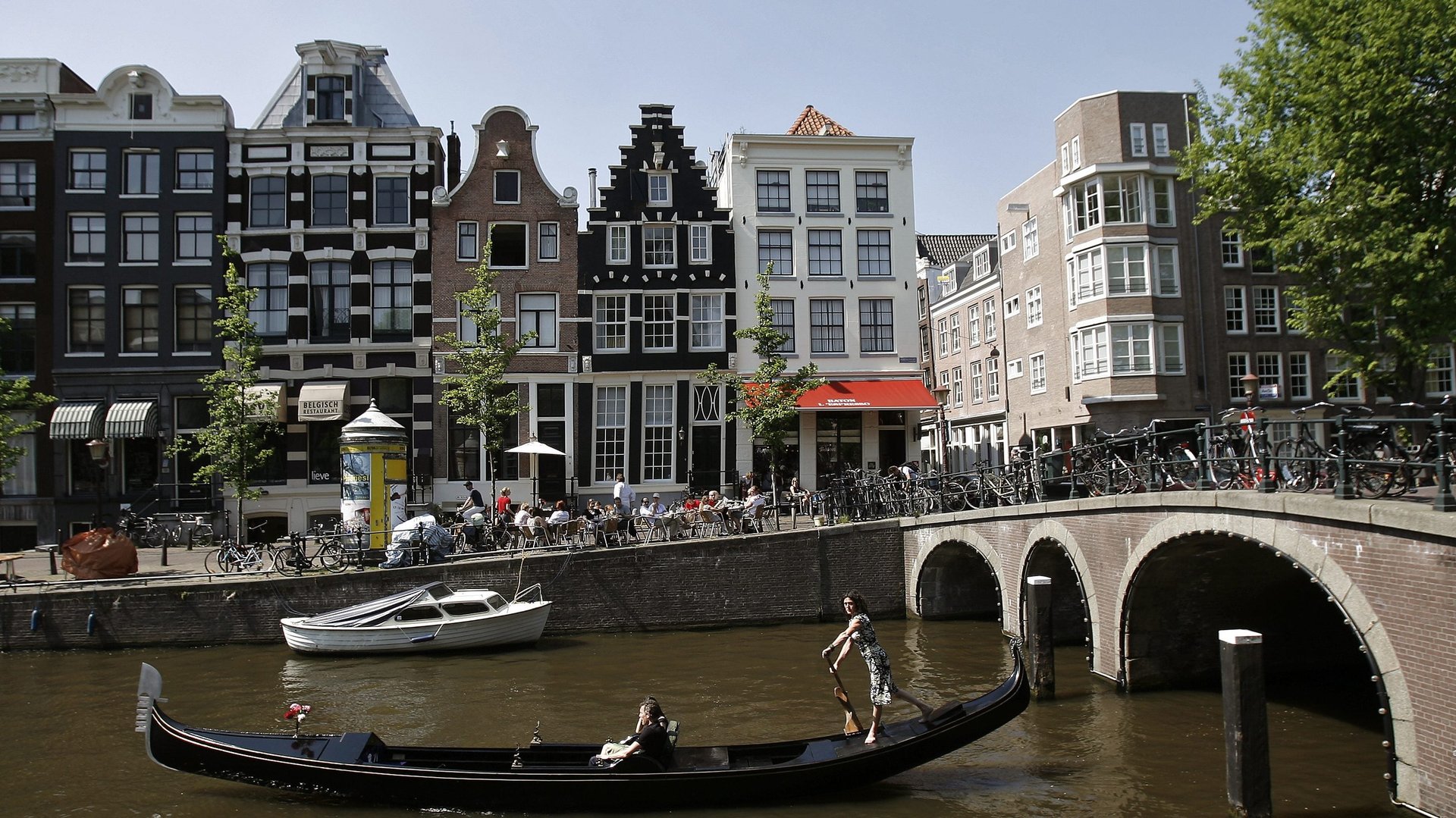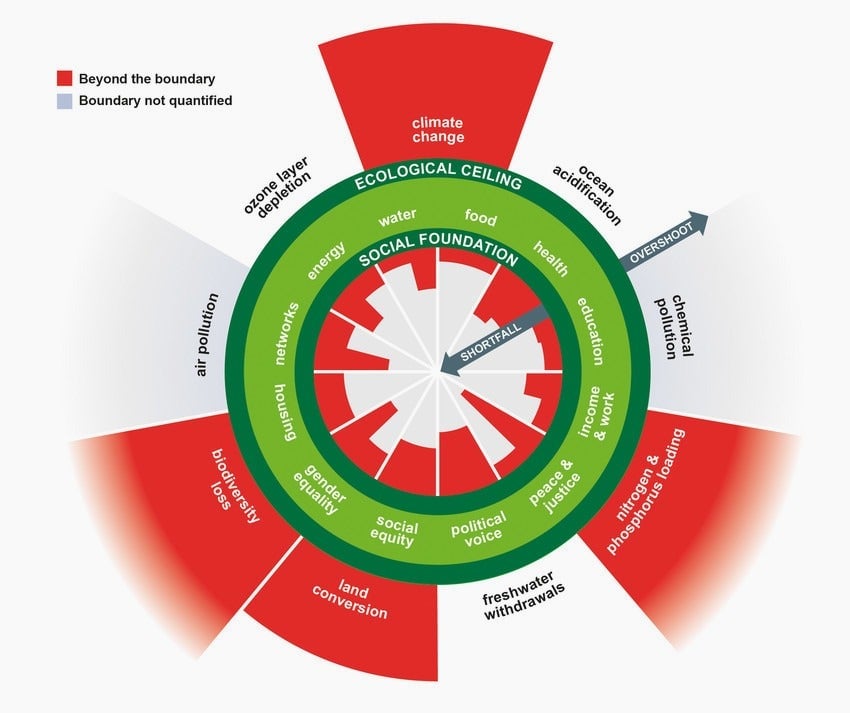The Dutch want to make big economic reforms with a doughnut
In the middle of the coronavirus pandemic, government leaders would love a crystal ball to help them manage the future of their homes’ economic health. Magic can’t help—but maybe a doughnut can.


In the middle of the coronavirus pandemic, government leaders would love a crystal ball to help them manage the future of their homes’ economic health. Magic can’t help—but maybe a doughnut can.
The city of Amsterdam this week officially decided to embrace what has come to be known as “The Doughnut Model,” a framework for sustainable development created by Oxford University economist Kate Raworth. In adopting this model, which attempts to balance the needs of people without harming the environment, the city hopes to emerge from the cloud of Covid-19 elbows out, with new purpose. The Dutch capital is the first city in the world to commit to the model, making it an economic experiment of a sort.
In an interview with The Guardian that took place before the decision was announced, Amsterdam’s deputy mayor Marieke van Doorninck said she thinks the model will help her city overcome the devastating effects of the novel coronavirus. If her government hopes to rebuild its economy and adequately address local socioeconomic and environmental shortcomings, she said, the government cannot revert to the status quo.
As a city leader, van Doorninck will help determine how policies will be shaped by the new economic model. The doughnut won’t provide answers on its own, she says, but it will provide a new way of looking at problems and finding their answers.
So what is “the doughnut?”
At the simplest level, the model makes the controversial case that a growing economy and ever-expanding GDP aren’t necessarily signs of economic health. It suggests that there are two large-scale problems facing humanity: poverty and climate change. The doughnut is an attempt to visualize and enable measurement of the relationship between the two.

The outermost wall of the doughnut represents issues of climate degradation—things like biodiversity loss, ozone depletion, ocean acidification, chemical pollution, and more. The innermost wall, the part that rings the doughnut hole, represents social issues—things like gender equality, jobs, social equity, income, affordable housing, and education.
Between these two rings (the actual cake of the doughnut) are the policies that define a functional city: an environmentally safe and socially just place in which humans can thrive. It reflects a happy medium that accounts for environmental health while satisfying basic social needs as laid out by the United Nations’ sustainable development goals. The doughnut model also visualizes where which goals are not being met or haven’t been set yet, shown in the above illustration in red and gray, respectively. Those areas indicate the need to recalibrate.
The model is conceptual (pdf), leaving the work of quantifying and setting specific goals to any government that would adopt it. The idea, though, is that successes in both social and environmental areas are intrinsically interlinked. Raworth points to current projections that climate change will continue to raise sea levels, shift seasons, and increase instances of droughts and floods. Those can in turn exacerbate poverty, access to clean water, and food security.
By the same token, people who live in poverty can be forced to use goods in ways that are environmentally unsustainable. It’s estimated that 2.7 billion people don’t have access to modern cooking equipment that makes better use of energy, forcing them to burn wood, charcoal, or other types of biomass that emit high levels of greenhouse gases or fumes that can cause health issues.
The hope is that accomplishing goals in one one area will organically help accomplish the goals of another. In Amsterdam, Dutch officials say initial steps will include making changes to how the city processes domestic trash, enforces sustainable construction work, tackles food waste, and reuses products.
“Global GDP is 10 times bigger than it was in 1950, and that increase has brought prosperity to billions of people,” Raworth has said in a TED Talk. “But the global economy has also become incredibly divisive, with a vast share of returns to wealth now accruing to a fraction of the global 1%. And the economy has become incredibly degenerative, rapidly destabilizing this delicately balanced planet.” The doughnut aims to reintroduce some of that stability.
New taste for an old concept
Challenging the concept that high growth rates equal economic success isn’t new. Raworth, a self-described renegade economist, has pointed to a March 1968 speech by Robert Kennedy, the brother of former US president John F. Kennedy:
“That Gross National Product—if we judge the United States of America by that—that Gross National Product counts air pollution and cigarette advertising, and ambulances to clear our highways of carnage. It counts special locks for our doors and the jails for the people who break them. It counts the destruction of the redwood and the loss of our natural wonder in chaotic sprawl. It counts napalm and counts nuclear warheads and armored cars for the police to fight the riots in our cities. It counts Whitman’s rifle and Speck’s knife, and the television programs which glorify violence in order to sell toys to our children.”
Those same contradictions resonate today. Take diet-related health as an example. Across the globe 13% of people are considered obese, a condition that can lead to heart disease, type 2 diabetes, and stroke. With that in mind, are the economic successes of Pepsico, The Coca-Cola Company, General Mills, and Mars Inc.—all makers of sodium-filled and sugar-laden snacks and drinks—to be celebrated? What about the financial triumphs of giant meat companies that support animal agriculture systems accounting for 14% of the world’s total greenhouse gas emissions?
“I think it’s time to choose a higher ambition,” Raworth has said in an interview with National Public Radio, “because humanity’s 21st century challenge is clear—to meet the needs of all people, within the means of this extraordinary, unique, living planet so that we and the rest of nature can thrive.”
In effect, the economic model asks policymakers to reward and encourage financial success not of business as a whole, but to targeted businesses with goods that serve to improve and preserve environmental health while also serving the peoples’ needs. It’s a concept reflected in the global trend of businesses working to be certified as B Corps, which acknowledge that a business can be measured by the good it does, not just the money it makes.
For Amsterdam, the trick is going to be finding a way to measure success without relying entirely on the metric of money. That will mean monitoring a range of indicators, some of which may be hyper-specific to the city itself. The cost of living in the city is so high, for example, that once residents pay for housing, 20% of people aren’t left with enough money to cover their basic needs. And when those people apply for public housing help online, only 12% find success, van Doorninck told The Guardian.
The solution would be for the city to build more houses for people. The problem is that carbon dioxide emissions for the city are already high, so to avoid exacerbating them builders would need to get creative about how they build houses, using recycled and bio-based materials.
It’s a complicated experiment: Introducing new indicators for success means the city will have all the more variables to track. Now, Amsterdam’s job is to test whether its hypothesis holds up in a real-world scenario.